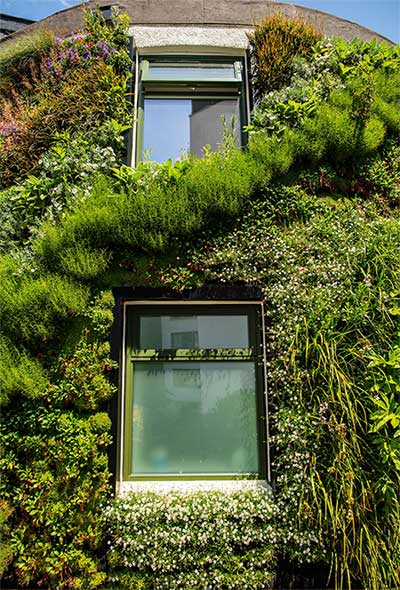A new study shows that covering building facades with vegetation can reduce heat loss through its structure by more than 30%.
The research conducted by the University of Plymouth in the UK took place at the Sustainability Center, a building dating back to the 1970s on campus. On the west-facing facade, scientists selected two walls at the same height, one of which was equipped with an additional biological covering, including a flexible felt system with soil-filled pockets for planting, and then compared its thermal retention effectiveness with the other wall.
After five weeks of measurements, the research team found that the heat loss through the “vegetation wall” was up to 31.4% lower compared to the original structure. They also discovered that daytime temperatures in the vegetated area were more stable, meaning less energy was required to heat it.

The fully vegetated wall of the Sustainability Center building. (Photo: University of Plymouth)
This is one of the first studies to identify the thermal impact of vegetation walls on existing buildings in the UK. Writing in the journal Building and Environment, lead author Matthew Fox emphasized that although this concept is relatively new, it has proven to provide numerous benefits.
“In the UK, about 57% of buildings were constructed before 1964. While recent regulations have changed significantly to improve the thermal performance of new constructions, it is the existing buildings in the UK that require the most energy for heating and contribute significantly to carbon emissions. Therefore, we must improve the thermal performance of current buildings if we want to achieve carbon neutrality by 2050 and reduce fuel consumption amid rising energy prices,” Matthew stated.
The University of Plymouth is renowned for its research in sustainable building technology. The school has received $2.6 million in support from the European Regional Development Fund (ERDF) to explore low-carbon solutions.
“With the growing urban population, ‘green infrastructure’ based on nature is a potential solution to combat climate change, air pollution, and biodiversity loss, while facilitating low-carbon economic growth. Biological walls not only save energy and reduce carbon emissions but also help improve air quality, reduce noise, and enhance health. However, further research is needed to optimize green wall systems to maximize environmental benefits and reduce some sustainability costs,” Dr. Thomas Murphy, co-author of the study, added.



















































